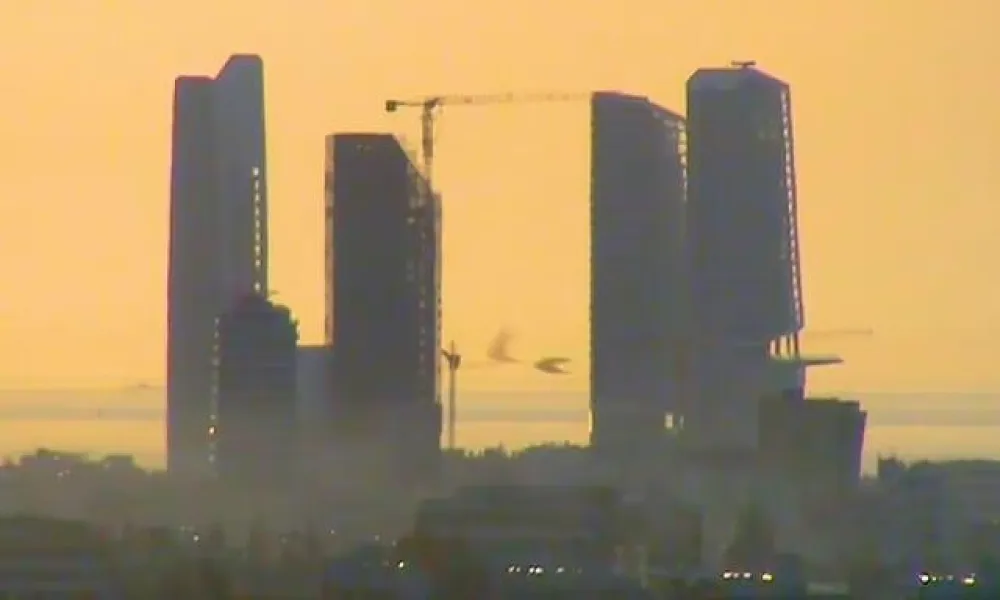An interview from Christothea Iacovou for Parathyro
In a city of towers and relentless development, Foivos Philitas turns his camera toward the people and the unseen corners behind Limassol’s polished skyline. As part of the Art Explora Festival and Limassol Art Walks, from 31 October to 2 November, he presents Façade, or how I stopped worrying and learned to love gentrification at Synergeio, a visual meditation on the city’s quiet metamorphosis. Speaking to Politis, he shares how his daily walks became both a documentary and an evolving archive of a city disappearing into rapid growth.
The origins of an urban archive
“I came back to Cyprus in 2020 after studying film and TV production in the UK,” Philitas says. “Seeing Limassol again through adult eyes, the change was striking, construction sites everywhere. Starting out as a photographer and videographer, I saw street photography as a field where I could practice, explore, and understand where I belonged. Through walking and observing, I tried to grasp what makes us Cypriot, the city’s rhythm, its aesthetics. I became fascinated by small, transitional moments: a sign about to fall, a corner half-demolished. They might seem insignificant, but together they reveal a city in flux.”
He describes watching skyscrapers rise as a kind of ritual. “The process interests me more than the finished tower. Seeing a building being born, it’s like witnessing a living organism growing before your eyes. The real story is in that transformation, in the people working tirelessly on these sites. They are the unseen hands building the city.”
A wordless film about gentrification
Philitas’s documentary avoids narration or interviews. “It’s not a traditional documentary,” he explains. “It’s based on images and sound, the viewer builds meaning through emotional associations. A subject like gentrification is complex; words often limit it. By leaving space, the audience can reach their own conclusions. My role as a filmmaker is to record this transitional moment, to sculpt the material as it unfolds.”
The project blends five years of photographs and three years of video footage. “It’s like sculpting,” he says. “I had 30 hours of footage from one building under construction. I kept about 18 as the film’s backbone and combined them with other city scenes -roads, sea, traffic, signs- to show both the micro and the macro view of change.”
From Instagram to exhibitions
Initially, Philitas shared his work on Instagram. “It started as an exercise, a way to practice daily and connect directly with an audience. Over time, these posts grew into projects. I like that through Stories, reality can enter the digital space, a worker on a scaffold, a street corner, an everyday moment.”
Last year, he exhibited this digital archive at Tapper, curated by Ria Alexandrou, as part of the Limassol Art Walks. “We used the vertical format of Instagram Stories, arranging them like a mosaic on a wall, a city built from pixels. The printed images became something tangible, a fragment of memory. I even handed out leftover prints to visitors as keepsakes, small memories of Limassol.”
The meaning behind the title
The work’s title, Façade, or how I stopped worrying and learned to love gentrification, plays with irony. “A façade is both the front of a building and a mask,” he says. “The rest of the title references Kubrick’s Dr. Strangelove. It’s partly humorous, my film has no dialogue, and I’m a man of few words. I prefer to let the images speak.”
Collaboration with The Island Club
The project is presented within The Right to Home: Diaries of Limassol’s Gentrification, curated by Androulla Kafa and organised by The Island Club. “They reached out last November,” Philitas recalls. “Androulla knew my work from Instagram. We met, and I showed her the footage. It fit perfectly with the festival’s theme.”
A diary of a changing city
Philitas sees his contribution as part of a collective diary. “Each participating artist from Limassol records the same transformation through their medium. A new Limassol is being built, whether it’s a bubble or a new reality, time will tell. But development brings inequality too: in wages, housing, and quality of life, especially for young people.”
Façade, or how I stopped worrying and learned to love gentrification will be shown at Synergeio, Limassol, from 31 October to 2 November, as part of The Right to Home: Diaries of Limassol’s Gentrification within the Art Explora Festival and Limassol Art Walks.
[More information: https://www.artexplora.org/el/festival/performance/the-right-to-home-diaries-of-limassols-gentrification--gr]
